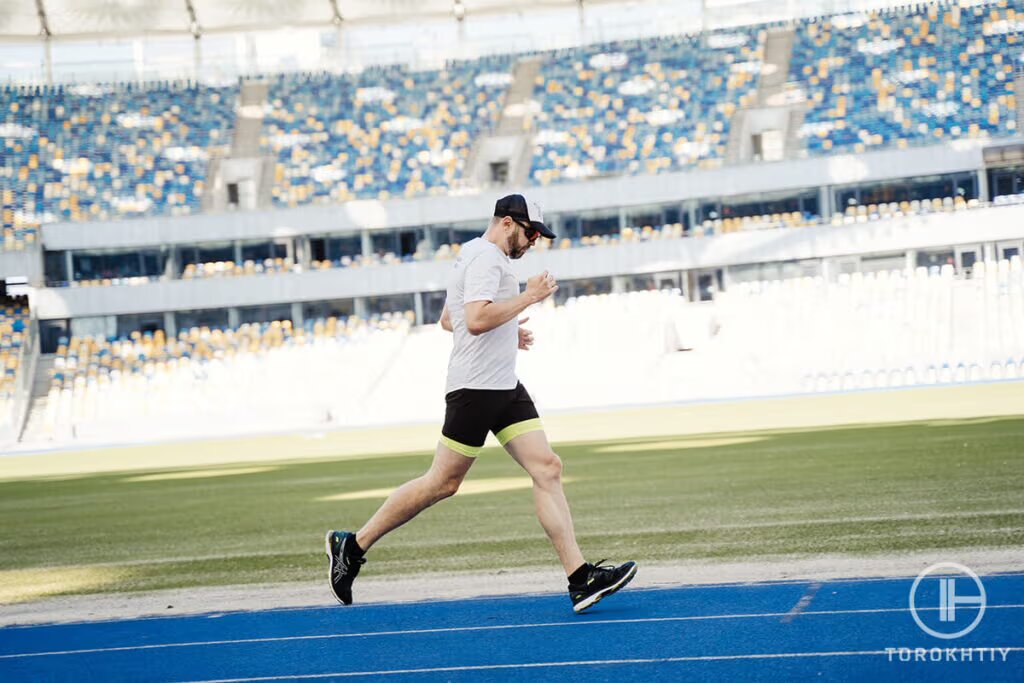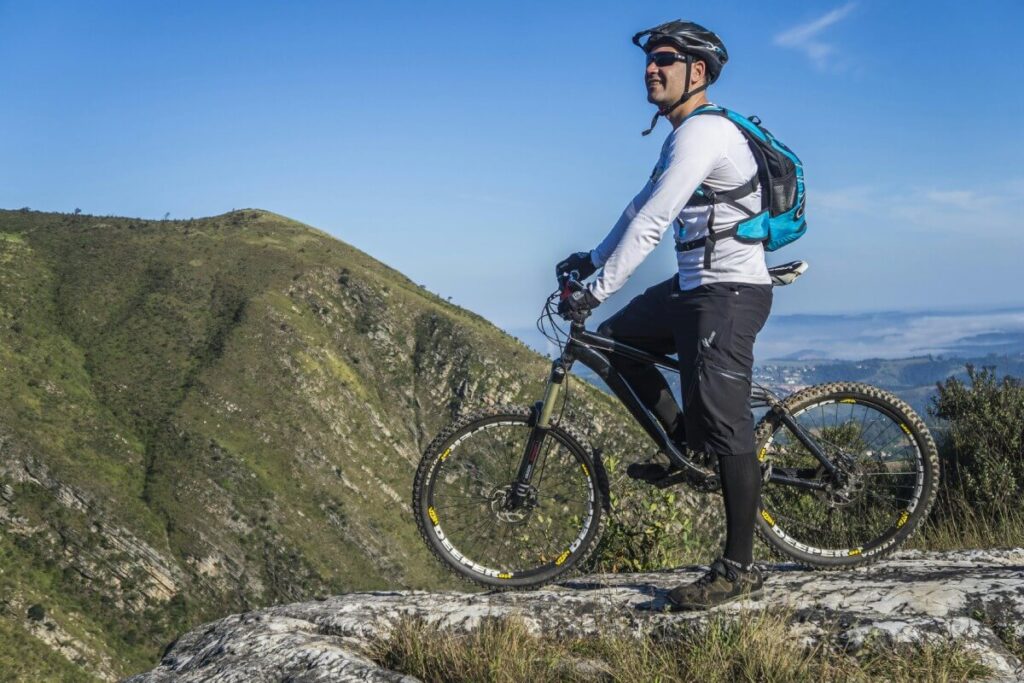100-Mile Training Plan: 8-Week Program + 7 Types Of Training
Author:
Unlock your full potential by engaging with our experts and community! Have questions about your fitness journey or looking for expert advice on weightlifting techniques? Don’t hesitate — leave a comment below and Oleksandr Zagrebelnyi will provide a personalized answer and insights to help you reach your goals.
Torokhtiy is reader-supported. Some links are affiliate links, and we may earn a commission at no extra cost to you. See our disclosure page for details.
If you’re an ultramarathon runner looking to take on the ultimate challenge, a 100-mile run is the pinnacle of endurance racing. However, preparing for such a grueling event requires a solid 100-mile training plan to ensure you’re physically and mentally prepared to go the distance. Without a proper training plan, it is unlikely that you will be able to complete the race, let alone perform well.
If you want to create a successful 100-mile run training plan, it is essential to understand the demands of the race and the unique challenges of running such a long distance. For those who want to know how to train for a 100-mile run, this post is for you. We’ll give you a detailed 100-mile ultra training plan and helpful tips on nutrition strategy and gear. Let’s dive in!
If you’re planning to run a 100-mile race, it’s essential to follow a proper training plan. A 100-mile run training plan includes a mix of long runs, hill repeats, speed work, and recovery days. It also gradually builds endurance and strength, ensuring you peak at the right time.

What Do You Need To Know About A 100-Mile Race?
A 100-mile race is an ultramarathon, which refers to any race that is longer than a traditional marathon. In fact, it is almost four times the distance of a standard 26.2-mile marathon. The race is typically held on trails, making it even more challenging due to the varying terrain and elevation changes.
A 100-mile race is not for everyone. It requires months of training and preparation to complete. The race is typically held over 24-48 hours, and runners must navigate through various checkpoints along the course. Additionally, the race is usually self-supported, meaning runners must carry their supplies, including food, water, and gear.
A 100-mile race is not open to anyone. That’s why beginners or those who have not run shorter ultramarathons before cannot participate in this event. Many races require runners to have completed a certain number of marathons or ultramarathons before they can register for the 100-mile race.
Pro Tip
Training for a 100-mile race takes months, and sometimes even years if you are a beginner. Start early and give yourself enough time to build your endurance.
Running Coach Nike Run Club Kyiv
A 100-mile race is considered one of the most challenging ultramarathons out there. Not only is the distance daunting, but the terrain can also be difficult to navigate. Additionally, the race requires runners to be mentally strong, as physical exhaustion can take a toll on even the most experienced runners. If you are not prepared for the race, it can be dangerous and potentially life-threatening.
How To Know Whether You Are Ready For A 100-Mile Run: Top 3 Criteria
Before you consider running a 100-mile race, you need to ensure you are mentally and physically ready for the challenge. So, how can you know whether you are ready for a 100-mile run?
1. The Importance Of Mental Preparation
Running a 100-mile race is not just about physical endurance, but also about mental toughness. You need to be mentally prepared to face the challenges of running such a long distance. Mental preparation involves setting achievable goals, developing a positive attitude, and staying motivated throughout the race.
You must be mentally strong enough to overcome the urge to quit and push through the pain. If you are not mentally prepared, you will likely give up before reaching the halfway point.
2. Physical Preparation
Physical preparation is equally important when it comes to running a 100-mile race. You need to train your body to handle the physical demands of running such a long distance. This involves building endurance, strength, and flexibility.
You must develop a training plan, including long-distance runs, strength training, and cross-training. It is also important to pay attention to your nutrition and hydration needs. You need to fuel your body with the right nutrients and stay hydrated throughout the race.
3. Experience And Training
Experience and training are key factors in determining whether you are ready for a 100-mile run. You should have experience running long distances before attempting a 100-mile race. Training on the terrain you will be running on during the race is also important. Additionally, you need to be aware of the cutoff times for the race and ensure you can meet them.

How Long Does It Take To Run 100 Miles?
The current world record for running a 100-mile ultramarathon for men is held by Alexander Sorokin from Lithuania. He completed the distance in 10 hours, 51 minutes, and 39 seconds on January 6, 2022, in Spartanion race in Tel Aviv, Israel.
The current world record for running a 100-mile ultramarathon for women is held by Camille Herron from the United States. She completed the distance in 12 hours, 42 minutes, and 40 seconds on December 9, 2017, at the Tunnel Hill 100-mile race in Vienna, Illinois.
Average Time For A 100-Mile Run
It’s important to note that the time it takes to run 100 miles varies greatly, depending on gender, age, and pace. According to different sources, the average time for men to run 100 miles is around 24 hours, while the average time for women is around 28 hours. However, this can vary greatly depending on the individual’s age, fitness level, and pace.
Here is a table that shows the average time for different age groups and paces:
| Age Group | Pace (min/mile) | Average Time to Complete 100 Miles |
|---|---|---|
| 20-29 | 10 | 16 hours, 40 minutes |
| 30-39 | 12 | 20 hours |
| 40-49 | 13 | 21 hours, 40 minutes |
| 50-59 | 14 | 23 hours, 40 minutes |
| 60-69 | 16 | 26 hours, 40 minutes |
| 70+ | 18 | 30 hours |
Running 100 miles is not just about physical fitness. It also requires mental strength and the ability to push through pain and discomfort. Races that are 100 miles or longer often have rugged terrain and extreme weather conditions and require runners to carry their supplies.
To prepare for a race, having a solid 100-mile ultramarathon training plan that includes running and strength training is important. It’s also important to have experience running long distances and to gradually increase mileage over time. Additionally, having a strong support system and mental toughness is crucial to completing a 100-mile race.
What Does The Training Plan For A 100-Mile Race Include: 7 Core Principles
Training for a 100-mile race is an arduous task that involves a lot of preparation. It is not just about building up your physical stamina, but also requires psychological readiness, proper nutrition, and specific training for the terrain and conditions of the race. Let’s outline the seven stages of preparation that are typically involved in a comprehensive training plan for a 100-mile race.
1. Physical Training
Physical preparation is the foundation of any training plan for a 100-mile race. This includes building endurance through long runs, speed work, and strength training. It is important to gradually increase mileage and intensity over time, focusing on injury prevention and recovery.
Cross-training with other activities, such as cycling and swimming, can also help to build overall fitness and reduce the risk of overuse injuries.

2. Psychological Preparation
Running a 100-mile race is not just a physical challenge, but a mental one as well. Building mental toughness and resilience through visualization, positive self-talk, and goal-setting is important. Many runners also find it helpful to practice mindfulness and meditation to stay focused and calm during the race.
3. Nutrition Strategy
Proper nutrition is essential for fueling the body during long runs and aiding in recovery after training sessions.
Runners should focus on a balanced diet that includes complex carbohydrates, protein, and healthy fats. It is also important to stay hydrated and replenish electrolytes during runs. Many runners find it helpful to work with a nutritionist to develop a personalized nutrition plan.

4. Terrain And Hill Training
The terrain in a 100-mile race can vary widely, from flat roads to steep mountain trails. It is important to train on terrain that is similar to the race course, including hill training to build leg strength and endurance. Many runners also incorporate stair climbing and hiking into their training to prepare for steep ascents and descents.
5. Night Running
Many 100-mile races include running through the night, which can be physically and mentally challenging. It is important to practice running in the dark, wearing a headlamp and reflective gear. Runners should also be prepared for changes in temperature and weather conditions during the night.
6. Recovery
Proper recovery is essential for preventing injuries and building endurance. This includes rest days, stretching, foam rolling, and massage. It is also important to listen to your body and adjust your training plan to avoid overtraining.

7. Time Commitment
Training for a 100-mile race requires a significant time commitment, often taking six months or more to prepare. It is important to plan your training schedule around work and other duties and to be prepared for the physical and mental demands of the training process.
Training Plan For A 100-Mile Race
Many runners wonder if they need a training plan to tackle a 100-mile run. While it may be possible to complete a 100-mile race without a structured training plan, having a plan will significantly increase your chances of success.
Why You Need A Training Plan For A 100-Mile Race
One of the primary benefits of having a training plan for a 100-mile race is that it helps you build the necessary endurance to complete the distance.
A training plan will help you gradually increase your mileage, allowing you to build up to the 100-mile distance over several months. Without a training plan, you may not have the necessary endurance to complete the race. You also risk injuring yourself by trying to run too far too soon.
Another benefit of having a training plan is that it helps you stay on track with your training. A plan will outline when and how much you should be running each week, helping you to stay motivated and focused. It also helps you track your progress, so you can make adjustments as necessary to ensure you’re on track to meet your goals.
Pro Tip
Having a training plan can help you avoid burnout. Running 100 miles requires significant time, energy, and mental toughness. A structured training plan ensures that you’re not overtraining or doing too much too soon, which can lead to burnout and injuries.
Running Coach Nike Run Club Kyiv
What Should Your Training Plan Include?
A training plan for a 100-mile race should include the following:
- Gradual mileage increases: Your plan should gradually increase your mileage each week, allowing you to build up to the 100-mile distance over several months.
- Rest days: Rest days are just as important as training days. Your plan should include regular rest days to allow your body to recover.
- Cross-training: Cross-training, such as cycling or swimming, can help you build endurance and prevent injury. Your plan should include cross-training activities that complement your running.
- Nutrition: Proper nutrition is essential for endurance athletes. Your plan should include recommendations for what to eat and drink before, during, and after your training runs.
7 Types Of Training To Help You Prepare For The 100-Mile Run
Preparing for a 100-mile race requires a comprehensive training plan that covers various areas, including strength, endurance, speed, hills, long runs, easy pace runs, and tempo runs. Let’s discuss seven examples of training that can help you prepare for a 100-mile race. These training exercises can be used to create a training plan that suits your fitness level and goals.
1. Strength Training
Strength training is essential for 100-mile race preparation. It helps to build muscle, increase endurance, and prevent injuries. Some examples of strength training exercises include squats, lunges, deadlifts, push-ups, and pull-ups. It is recommended to do strength training two to three times a week.

2. Endurance Training
Endurance training is crucial for a 100-mile race, as it helps to build stamina and improve cardiovascular health. Endurance training includes long runs, steady-state runs, and interval training. It is recommended to do endurance training three to four times a week.
3. Hill Training
Hill training is an excellent way to build leg strength, improve running form, and increase endurance. Examples of hill training include hill repeats, uphill sprints, and downhill runs. It is recommended to do hill training once a week.
4. Long Runs
Long runs are an essential part of preparing for a 100-mile race. It helps to build endurance, improve stamina, and prepare your body for long-distance running. Try to do one long run per week, gradually increasing the distance each week.
5. Easy Pace Runs
Easy pace runs are an essential part of recovery and building endurance. They help to increase blood flow, improve cardiovascular health, and prevent injuries. It is recommended to do easy pace runs two to three times a week.
6. Tempo Runs
Tempo runs are an excellent way to increase speed, improve running form, and build endurance. They involve running slightly faster than your usual pace for a sustained period. It is recommended to do tempo runs once a week.

7. Speed Training
Speed training is an essential part of preparing for a 100-mile race. It helps to increase speed, improve running form, and build endurance. Examples of speed training include intervals, fartleks, and hill sprints. It is recommended to do speed training once a week.
Rest And Recovery
A common mistake many runners make is focusing solely on increasing mileage and intensity, while neglecting the crucial aspect of rest and recovery. Rest and recovery are essential for the body to adapt and become stronger.
During rest periods, the body repairs damaged tissues, replenishes energy stores, and strengthens the immune system. Inadequate rest can lead to injury, fatigue, and burnout. Incorporating rest and recovery into your training plan can help you avoid injury and perform better on race day.
You can use several strategies to incorporate rest and recovery into your 100-mile run training plan. First, make sure to include rest days in your training schedule.
Rest days allow the body to recover and reduce the risk of injury. Second, consider cross-training activities such as yoga, swimming, or cycling on your rest days. Cross-training activities can help improve flexibility, mobility, and cardiovascular fitness.
Pro Tip
In addition to rest days, you can also use active recovery techniques to help your body recover more quickly. For example, foam rolling, massage, and stretching can help improve circulation and reduce muscle soreness.
Running Coach Nike Run Club Kyiv
Third, prioritize sleep and nutrition. Adequate sleep and a balanced diet are crucial for optimal recovery.
Another important aspect of rest and recovery is getting enough sleep. Sleep is when your body does most of its repair work, so it’s essential to get enough of it to support your training goals. Aim for at least seven to eight hours of sleep per night, and establish a regular sleep schedule to help your body adjust.
8-Week Training Plan For Running 100 Miles
Here is an example of an eight-week training plan that will help you prepare for running 100 miles. The weekly plan includes two rest days, one strength training day, and four different types of running workouts.
| Week | Monday | Tuesday | Wednesday | Thursday | Friday | Saturday | Sunday | Total Weekly Mileage |
|---|---|---|---|---|---|---|---|---|
| 1 week | Rest day | 10-mile long run | 4 x 800m interval run | 5-mile hill run | Rest day | 6-mile night run | Strength training | 35 miles |
| 2 week | Rest day | 12-mile long run | 6 x 400m interval run | 6-mile hill run | Rest day | 7-mile night run | Cross-training | 41 miles |
| 3 week | Rest day | 14-mile long run | 8 x 200m interval run | 7-mile hill run | Rest day | 8-mile night run | Strength training | 47 miles |
| 4 week | Rest day | 16-mile long run | 10 x 400m interval run | 8-mile hill run | Rest day | 9-mile night run | Cross-training | 53 miles |
| 5 week | Rest day | 18-mile long run | 12 x 200m interval run | 9-mile hill run | Rest day | 10-mile night run | Strength training | 59 miles |
| 6 week | Rest day | 20-mile long run | 14 x 400m interval run | 10-mile hill run | Rest day | 11-mile night run | Cross-training | 65 miles |
| 7 week | Rest day | 22-mile long run | 16 x 200m interval run | 11-mile hill run | Rest day | 12-mile night run | Strength training | 71 miles |
| 8 week | Rest day | 24-mile long run | 18 x 400m interval run | 12-mile hill run | Rest day | 13-mile night run | Cross-training | 77 miles |
You can use this sample workout plan to create your own 6-month, 100-mile training plan. You may need to gradually increase your weekly distance, or you may be able to run long distances if you are an experienced athlete. Try different running load combinations to develop endurance, as this is the main key to successfully completing a 100-mile race.
Pro Tip
Before starting the actual training, building a strong running base is essential. You can do this by running 30-40 miles a week for at least six months. This will help you prepare your body for the intense training that lies ahead.
Running Coach Nike Run Club Kyiv
4 Must Have Things You Need To Run 100 Miles Effectively
Running 100 miles can be both a challenging and fulfilling experience. However, it requires a lot of preparation and planning to do it effectively. In this section, we will discuss some essential items you need to carry with you, including clothes, shoes, accessories, gear for night runs, food, and drinks.
1. Hydration Pack
Before embarking on a 100-mile run, preparing everything you will need during the race is crucial. A hydration pack or vest is an essential item that can help you carry water, electrolytes, and other essentials.
In addition, you may need to carry a first aid kit, a headlamp, extra batteries, a map, and a compass. Ensure you have enough space to carry everything you need, and that the pack is comfortable to wear for long periods.
2. Clothes And Shoes
Wearing the right clothes and shoes is important for a successful 100-mile run. Choose moisture-wicking clothes that will keep you dry and comfortable. Avoid cotton clothes, as they tend to retain moisture and can cause chafing.
Shoes should be well-fitted and comfortable, with adequate cushioning to absorb the impact of running on hard surfaces. Consider wearing gaiters to prevent debris from entering your shoes.
Hoka Bondi 8
- Material: Breathable and supportive mesh upper
- Sole Material: Full-length EVA midsole for maximum cushioning
- Outsole (tread feature): Durable rubber outsole with a unique lug pattern
- Drop: 4mm
- Season: Suitable for all seasons
- Special Features: Exceptional cushioning and comfort
- Size: Available in various sizes
- Type: Maximum cushioning running shoe
If you want excellent running or walking shoes or just footwear you’ll be comfortable in, you can’t go wrong with the Hoka Bondi 8.
It’s been upgraded and now they have lighter, softer materials and a new extended heel design. The heel design gives a super soft, balanced feeling from th emoment your heel hits the ground to when you push off with your toes.
As far as the weight goes, it’s around 10.80 ounces, and the heel drop is 4 mm. They’re not too heavy and the lower drop is a good balance between cushioning and feeling connected to the ground.
The Bondi 8 is focused on cushioning and keeps things simple. There’s a good amount of support without any extra stuff that you don’t really need and that would only jack up the price. Take the rear crash pad, for example – it makes for a soft, smooth ride, which is perfect if you like to run outdoors.

The upper part is made of engineered mesh, which is breathable and keeps your feet cool and dry. The tongue and collar have memory foam and mold to your foot shape. All of these features make the fit snug but flexible, which is exactly what you would want.
The Bondi 8 is eco-friendly because it uses recyclable materials in parts like the mesh and the sockliner. Plus, the shoes are completely vegan, which (if that’s important to you) is nice!
3. Gear For Night Runs
If you plan to run through the night, you need additional gear to stay safe and comfortable. A headlamp is an essential item that will help you navigate the trail in the dark. Make sure you carry extra batteries or a rechargeable battery pack.
A reflective vest or shirt is also necessary to make you visible to other runners or vehicles. Consider wearing warm clothes and carrying a lightweight sleeping bag if you plan to take a quick nap during the night.
4. Foods And Drinks
During a 100-mile run, it is important to consume a lot of calories and fluids to keep your energy levels up. Try energy bars, gels, or chews that provide a combination of carbohydrates, proteins, and fats.
Drink water, electrolyte drinks, or sports drinks to stay hydrated. You may also need to carry salty snacks to replenish the sodium lost through sweat. Avoid trying new foods or drinks during the race, as they may upset your stomach.
Pro Tip
Practicing your nutrition and hydration strategy during your training runs is essential. You can experiment with different foods and hydration options before the race to find what works best for you.
Running Coach Nike Run Club Kyiv
Short Summary Of 100-Mile Training Plan
To prepare for a 100-mile run, here is a comprehensive to-do list that you can follow:
- Start by gradually increasing your weekly mileage. This will help you to build endurance at a steady pace without overexerting yourself.
- Incorporate hill training to build strength and endurance. Hill training is an excellent way to build lower body strength, improve cardiorespiratory fitness, and increase your running speed.
- Include tempo runs to improve speed and stamina. Tempo runs involve running at a comfortably hard pace for a sustained period of time to improve your endurance and speed.
- Introduce long runs to build endurance. Long runs will help you to develop the ability to cover long distances without getting tired.
- Make sure to take rest days to prevent injury and allow for recovery. Rest days are as important as training days, because they allow your body to recover and prevent overtraining.
- Cross-train with low-impact exercises such as swimming or cycling. Cross-training is an excellent way to give your running muscles a break while maintaining your fitness.
- Practice nutrition and hydration strategies for long-distance running. Proper nutrition and hydration are critical for long-distance running performance. You should pay attention to what you eat and drink before and during the race.
- Consider joining a running group or finding a training partner for motivation and accountability. Running with others can help you stay motivated and accountable and allow you to learn from other runners.
- Increase mileage and intensity gradually to prevent burnout and injury. Gradual increases in mileage and intensity will help you build stamina without harming your body.
- Plan for tapering and recovery time leading up to the race. Tapering is the gradual reduction of mileage and intensity leading up to the event, allowing your body to rest and recover before the big day.
By following this comprehensive training plan, you’ll be well on your way to completing a 100-mile run. Good luck!

FAQ
Can I Train For A 100-Mile Race In Six Months?
Training for a 100-mile race is daunting, but it’s doable in six months! It’s important to have a solid training plan, listen to your body, and prioritize rest and recovery. Make sure to increase your mileage gradually, incorporate strength training, and practice nutrition and hydration strategies during your long runs.
Minimum Training For A 100-Mile Race?
If you’re planning to run a 100-mile race, it’s important to have adequate training. The minimum training required for this type of race includes consistent long runs, strength training, rest, and proper nutrition. It’s recommended to gradually increase mileage and incorporate hills and trails into your training.
How Many Miles A Week Should I Run When Training For A 100-Mile Race?
You need to put in some serious mileage if you’re training for a 100-mile race. Most training plans recommend averaging around 70-100 miles per week in the months leading up to the race. However, the exact mileage depends on your fitness level and goals. Be sure to listen to your body and adjust your training as needed.
Conclusion
In conclusion, a 100-mile race is not for the faint of heart. It requires intense training, preparation, and mental toughness to complete. It is recommended that runners have experience with shorter ultramarathons before attempting the 100-mile race. That being said, if you are up to the challenge, a 100-mile race can be a rewarding and life-changing experience.
Preparing for a 100-mile race requires a well-rounded training plan covering various fitness areas. Incorporating strength training, endurance training, hill training, long runs, easy pace runs, tempo runs, and speed training can help you build stamina, increase speed, improve running form, and prevent injuries.
Remember to create a training plan that matches your fitness level and goals.
Good luck with your 100-mile race preparation!
Do you have any questions about the 100-mile race training plan? Please share your thoughts in the comments below.
Also read:
References:
- Analysis of performance and age of the fastest 100-mile ultra-marathoners worldwide // PMC: https://www.ncbi.nlm.nih.gov/pmc/articles/PMC3654294/
- A macro to micro analysis to understand performance in 100-mile ultra-marathons worldwide // Scientific Reports – Nature: https://www.nature.com/articles/s41598-023-28398-2
- Race Diet of Finishers and Non-Finishers in a 100 Mile (161 km) Mountain Footrace // ResearchGate: https://www.researchgate.net/publication/221829918_Race_Diet_of_Finishers_and_Non-Finishers_in_a_100_Mile_161_km_Mountain_Footrace
- Influence of a 100-mile ultramarathon on heart rate and heart rate variability // BMJ Journals: https://bmjopensem.bmj.com/content/7/2/e001005
- Pain Perception After Running a 100-Mile Ultramarathon // ScienceDirect: https://www.sciencedirect.com/science/article/abs/pii/S0003999307003309
- What Running 100 Miles In A Day Does To Your Body // ACSH: https://www.acsh.org/news/2018/09/24/what-running-100-miles-day-does-your-body-13440
- Photos are made by Torokhtiy Media Team, Pixabay Pexels
Why Trust Us?
With over 20 years in Olympic weightlifting, strength training, nutrition coaching, and general fitness our team does its best to provide the audience with ultimate support and meet the needs and requirements of advanced athletes and professional lifters, as well as people who strive to open new opportunities and develop their physical capabilities with us.
By trusting the recommendations of our certified experts in coaching, nutrition, and sports training programming, as well as scientific consultants, and physiotherapists, we provide you with thorough, well-considered, and scientifically proven content. All the information given in the articles concerning workout programming, separate exercises, and athletic performance, in general, is based on verified data.
The product testing process is described in more detail here.
Oleksandr is a running coach and member of the Nike Run Club coaching team for 8 years. A participant in national and international competitions at distances from one kilometer to the ultra trail. Owner of mountain trail running camps. Nowadays Oleksandr is responsible for creating running training programs for athletes of various levels, coaching personally offline and online, conducts trail running camps in the mountains, participates in competitions.




Still have questions after reading our article? Unlock your full potential by engaging with our experts and community! Don’t hesitate — leave a comment below and Oleksandr Zagrebelnyi will provide a personalized answer and insights to help you reach your goals.